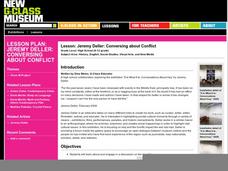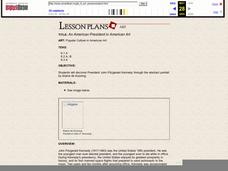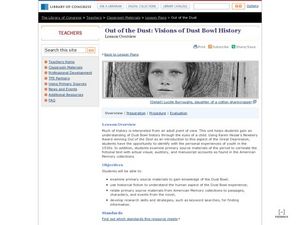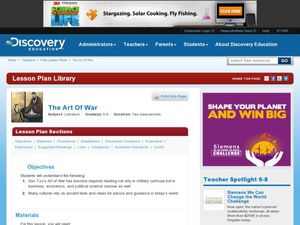Curated OER
Lesson: Jeremy Deller: Conversing about Conflict
Bridge cultural awareness, community, government, and art with an introspective and thought-provoking lesson. Upper graders become globally and socially aware as they analyze and explore the art of Jeremy Deller. They consider his images...
National Gallery of Canada
Make a Parfleche
Examine American Indian art and culture by observing contemporary art and creating original pieces. Class members discuss artwork included in the plan and use these images to help inspire their own work, which should represent their...
PBS
Lesson Plan: Divided Opinions
To gain a more in-depth understanding of the tumultuous 1960s, young historians examine video clips, listen to music, examine images, and interview survivors. Once they have a foundation of information about the period, class members...
Curated OER
Lesson: Nimble Symbols
Comparative thinking is one way to build critical analysts. Budding artists discuss symbols and how they represent concepts, beliefs, or ideas. They compare the symbols found on an ancient Egyptian mummy case to those found in...
Azar Grammar
Women’s History Month Eleanor Roosevelt : Verb Corrections
Read a short passage about Eleanor Roosevelt while hunting for errors in verb use. To give your kids some help, count up the errors beforehand and provide struggling learners with the number of errors.
Walters Art Museum
The Symbolism of Allegorical Art
Introduce learners to allegorical art with four bronze sculptures by Francesco Bertos. After modeling how to recognize bias and allegory in Bertos' Africa, class groups examine the other three sculptures in the series before creating...
Curated OER
An American President in American Art
Learners discuss the life and death of both Elaine De Kooning and the president she painted, John Kennedy. They learn how Kooning chose to describe President Kennedy through abstract expressionism and why her choice of color and shape...
Curated OER
The History of Photography
By discussing the history of photography, students can learn about this art and its importance in recording major events.
Curated OER
Living History- An Intergenerational Philanthropy
Students gather information from a senior friend to write a biography. In this living history books lesson, students organize information to complete a book about their senior friend. Detailed teacher instructions for completing the book...
Curated OER
Eyewitness to History
Young scholars explore historical connections, talking with family members about landmark events they have witnessed in their lifetimes to explore how history touches our lives. They identify several landmark events of the late 20th...
Curated OER
Ancient Ones
Students read the story Ancient Ones about a forest that is connected to all the life around it. In this reading lesson plan, students also create a tall folding book about the forest.
Curated OER
Cuisine Art
Students explore the history of the foods of different ethnic groups and the significance of these foods in perpetuating culture.
Curated OER
Out of the Dust: Visions of Dust Bowl History Lesson Overview
Students complete activities with the book Out of the Dust by Karen Hesse. In this literature lesson, students read this story and view the Dust Bowl history from the eyes of a child. They discover the Great Depression and life in the...
Curated OER
Recalling History by Pulling Strings
Students investigate the role and nature of story-telling as it preserves history and culture and discuss how puppetry serves as an effective method of presentation. They create basic outlines for puppet shows that relay important...
Curated OER
It's Art ... Naturally
Students consider the ways nature has been used in art, and then design and create their own original sculptures using materials from nature for a class exhibit.
Curated OER
The Art Of War
Students analyze the military, business, and political implications of Sun Tzu's book The Art of War. In this literature lesson plan, students read and discuss the novel prior to interviewing business people about business practices that...
Curated OER
Spin Art
The best part about spin art is that is demonstrates the concept of centrifugal force. Explore the magical spin of gravity as you make colorful art. This lesson idea is short, very simple, and requires a spin art machine.
New York City Department of Education
Egypt
This six-week unit encompasses all subjects with a focus study on world history and the development of ancient civilizations. As gifted and talented students dive into the interesting yet challenging topic of Egypt, they think critically...
Gateways
Teaching the Easter Story
If you are looking for a secular approach to teaching about Easter, this may just be the resource for you. Pupils read a paraphrased text depicting the last supper, arrest, and crucifixion of Jesus Christ as told in the Bible, while also...
Dick Blick Art Materials
No-Blender Pulp Painting
Like finger painting, this project is very tactile. Kids tear tissue paper into small pieces, add water, and mix up a pulp that can be pressed onto a canvas to create a colorful, textured painting.
MENSA Education & Research Foundation
Utopia/Dystopia: The American Dream
America was founded by dreamers, and the American dream still resonates in our country today. Track the American dream from its Puritan beginnings to its optimistic descendants with a instructional activity that focuses on speeches by...
Arts Midwest
The Joy Luck Club: Culture and History
Explore San Francisco's Chinatown in a lesson about the first few chapters of The Joy Luck Club by Amy Tan. Kids research Chinatown on the Internet and create a virtual tour of the neighborhood, including the foods, cultural events, and...
Curated OER
The Art of Marie Goth
Fifth graders examine the history and art of the Indiana artist Marie Goth. They create a timeline of events in Marie Goth's life and discuss historical events that happened during her lifetime. Students then view portraits and...
Lesson Planet
Black History Month- Lessons For Everyone
Black History Month lesson plans provide a way to meet academic standards, and have students learn about a variety of subjects.

























